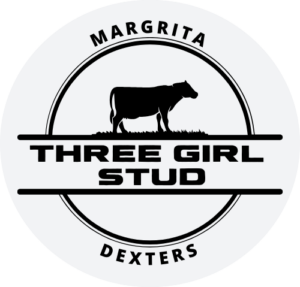Dexter cattle are a unique and ancient breed originating from Ireland, known for their small size and dual-purpose utility as both dairy and beef animals. The genetics of Dexter cattle are distinguished by their compact stature, with adult cows typically weighing between 600 to 700 pounds and bulls between 1,000 to 1,200 pounds. Let’s examine their genetics in more detail.
This breed’s small size is largely due to a naturally occurring genetic mutation. One key genetic trait in Dexter cattle is chondrodysplasia, a form of dwarfism, which can result in shorter limbs and a stockier body. This condition is inherited in a simple recessive manner, meaning that a calf must inherit the gene from both parents to exhibit the trait. Breeders often perform genetic testing to manage this trait, ensuring that chondrodysplasia does not negatively impact the health and functionality of the herd.
Another significant genetic feature of Dexter cattle is their coat colour, which is primarily determined by two genes: the melanocortin 1 receptor (MC1R) gene and the agouti signalling protein (ASIP) gene. These genes interact to produce three main coat colors: black, red, and dun. The MC1R gene has two main alleles that control the production of black or red pigment, while the ASIP gene influences the distribution of pigment, resulting in the dun colour when combined with the recessive form of the MC1R gene.
Breeders selectively manage these genetic traits to maintain the desired characteristics and diversity within their herds. Overall, the genetics of Dexter cattle contribute to their unique appeal, combining their small stature, varied coat colours, and the potential for both milk and meat production into a versatile and hardy breed.
Dexter cattle genetics are a fascinating study in the management of inherited traits to optimize the breed’s performance and appearance. One of the key aspects of their genetics is the diversity found within their population, which allows breeders to select for various desirable traits. This diversity contributes to the breed’s hardiness, adaptability, and efficiency in converting feed into high-quality meat and milk, making them well-suited to a range of environments and management systems.
Breeding strategies in Dexter cattle often focus on improving characteristics such as fertility, calving ease, and longevity, all of which are important for maintaining a sustainable herd. Genetic testing has become an essential tool in managing the health and productivity of these cattle. It allows breeders to identify and select traits that enhance the breed’s overall resilience and profitability.
Another aspect of Dexter cattle genetics is the emphasis on maintaining genetic diversity to avoid inbreeding, which can lead to a reduction in vigor and increased susceptibility to diseases. By carefully managing breeding pairs and utilizing genetic testing, breeders can ensure the long-term health and viability of their herds, preserving the unique qualities of this versatile breed.
Three Girl Stud Genetics
‘Hope’, the first heifer of the Margrita Dexter Stud, has passed on the genetics of the outstanding English Sire ‘Bookham Roberts’. Late in 2007, 6 more of his straws were added and we suspect these are the last of this amazing line.
Purchasing Lyndondales herd then gave us access to 3 more ‘Bookham Roberts’ and a ‘Ben MacDhui’ Female as well as semen from Sires ‘Bedford Romarc Rambler’, ‘ Trillium Chabotte’ and ‘Cranworth Samson’. All are no longer available and none were a Carrier of ‘Chondrodysplasia’. As well we have also used a lot of the ‘Cornihir Outlaw Line’.
The Grand Dam of the Herd, of course, is the wonderful ‘Kadina Irish Blossom’, owned by Don and Serena Garland.
We would love the opportunity to speak to you in more detail about our Dexters. Get in touch with us today.
